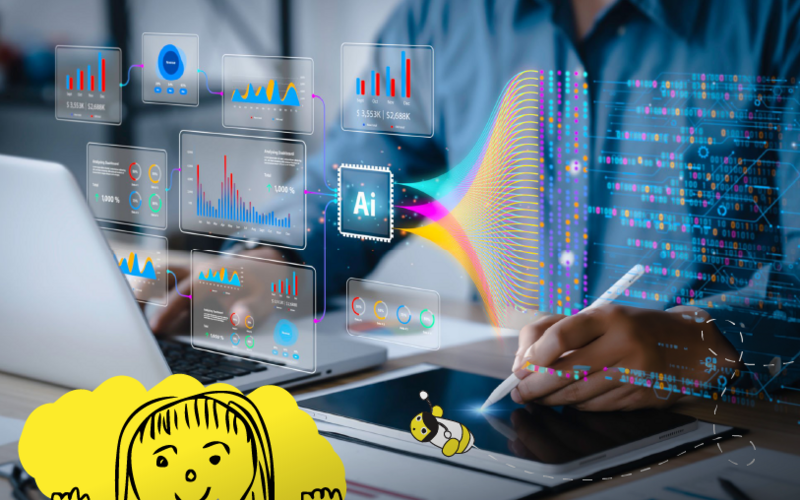Published Date: 21st August 2024
As part of our series on artificial intelligence in recruitment, we’re exploring the areas where AI has the potential to elevate the standards of recruitment and to undermine them.
We’ve previously highlighted the bias risks that AI can create within the recruitment process, but can organisations actually use it for good? The answer might be yes – if you tread carefully and understand your requirements before diving in.
We’ll highlight the areas where AI can be used to make recruiting more human and, by extension, help build more diverse and inclusive workforces.
Personalised Communication with Jobseekers
Arguably the best current use case for artificial intelligence in recruitment is its ability to manage communications with job applicants at scale. Many hiring managers are already struggling to respond to job applications within reasonable timeframes, especially with the number of applications per role rising significantly in recent times. In these conditions, candidate experience can take a hit, potentially damaging a company’s reputation as an employer.
Software that updates candidates about the status of their job applications by email is one way to cut down all that time spent on responding to people – which can quickly get out of hand with dozens of applications coming in.
Other companies have taken the idea one step further by using AI-powered chatbots on their websites to provide instant responses to jobseeker queries. Another use of AI is to send alerts to candidates in your ATS database about new job vacancies that may suit their profile. These are useful ways of engaging with jobseekers and applicants outside of business hours, especially for younger generations who prefer texting to phone calls.
Interview Scheduling
Organising interviews that fit into the schedule of the hiring manager, HR and the candidate can be a time-consuming process all by itself. One of the more convenient uses of AI is to automate this process, allowing candidates to choose convenient times and reducing the back-and-forth of email exchanges.
Good quality AI-powered tools can effectively manage conflicting appointments and automatically send updates about interview schedules, ensuring that your candidates are informed and well-prepared.
Identifying Transferrable Skills
Most modern applicant tracking systems have resume screening features that can highlight potentially suitable applicants based on keyword analysis.
Setting keyword filters that are too strict can hinder your search for good candidates. A global study by Harvard Business School found that 88% of employers said qualified, highly skilled candidates are often vetted out of the selection process because they do not match the exact criteria in the job description.
However, it’s possible to buck this trend. Depending on how you set ATS filters, you could identify not just candidates who tick all the boxes with their qualifications and previous job titles but also those who have transferrable skill sets.
To make this work, it’s important to put some thought into what keywords can capture transferrable skills that might not be found in a typical job description for a role.
Bias Reduction
We’ve explored the bias-related risks of AI in detail in our previous blog, but it’s worth noting that AI tools can also work in reverse to reduce bias.
AI tools can scan resumes and anonymise candidate information, such as names (ethnicity), gender, or date of birth, creating ‘blind’ resumes. This approach can be helpful in streamlining resume screening without introducing unconscious bias.
Automating this process enables hiring managers to focus their efforts on more nuanced aspects of candidate evaluation, like cultural fit and specific skill sets.
Managing the Risks of AI Recruiting Tools
Use Safeguards
Before your organisation uses artificial intelligence tools in recruiting activities that involve filtering resumes or assessing candidates in any way, it’s essential to have safeguards in place.
In practice, safeguards would include explicit company policies about how AI is used in the recruitment process and monitoring the outcomes of the hiring process involving AI.
As researchers have noted, ‘while the vendors of [AI] tools may conduct internal testing and auditing, the results are often not publicly available. Independent external auditing is rare’. The onus is on your organisation to ensure AI isn’t distorting the recruitment process and raising legal risks around discrimination.
Be Transparent
Candidates are likely to appreciate transparency about the AI tools your organisation is using to communicate with them and screen their resumes. It’s best to be upfront about this, as candidates can easily spot where AI is being used.
Evaluate Why AI is Necessary
Plenty of organisations have fallen into the trap of adopting technology simply because it appears impressive – the phenomenon often referred to as "shiny object syndrome." Acquiring new tech tools won’t help you identify weaknesses in your recruitment process, which often stem from human practices. Working with human recruiters with years of experience is the most efficient way to address your unique needs.
Remember the ‘Human’ in the Process
AI can potentially liberate us from time-consuming administrative tasks and speed up hiring, which is a benefit for organisations and provides a smoother experience for candidates.
However, it’s still essential to keep candidates at the centre of recruitment. Candidates ultimately prefer interacting with humans who can help them feel understood and supported through the hiring process.
At Beyond Recruitment, we take pride in bringing a sensitive and nuanced touch to our services to clients and candidates. Holding fast to our diversity and inclusion principles, we take care to understand the unique needs of your business and team culture to find the best talent. Please get in touch with our New Zealand recruitment team to find people who can’t be identified by software.





